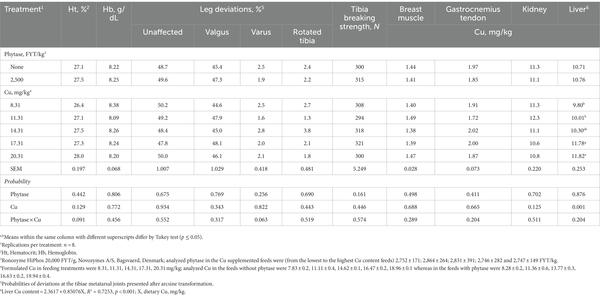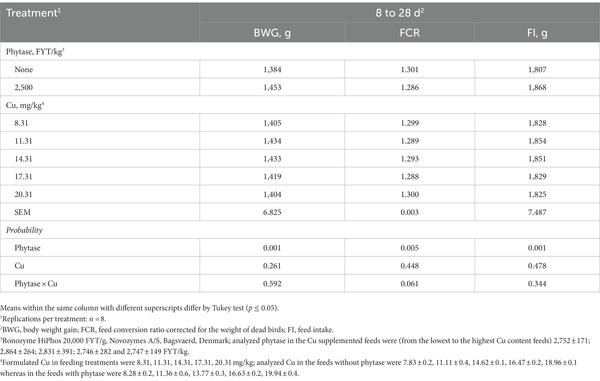Dietary phytase effects on copper requirements of broilers




1. Pang, Y, and Applegate, T. Effects of copper source and concentration on in vitro phytate phosphorus hydrolysis by phytase. J Agric Food Chem. (2006) 54:1792–6. doi: 10.1021/jf052053b
2. NRC, National Research Council. Nutrient requirements of poultry. 9th ed. Washington, DC: Natl. Acad. Press (1994).
3. Cobb-Vantress. COBB 500 broiler performance & nutrition supplement. Siloam Springs, AR: Cobb-Vantress Inc. (2018).
4. Rostagno, HS, Albino, LFT, Hannas, MI, Donzele, JL, Sakomura, NK, Perazzo, FG, et al. Brazilian tables for poultry and swine: composition of foods and nutritional requirements. 4th ed. Viçosa: UFV (2017).
5. Aviagen. Ross 408 parent stock: nutrition specifications. Huntsville, AL: Aviagen (2017).
6. Arias, VJ, and Koutsos, EA. Effects of copper source and level on intestinal physiology and growth of broiler chickens. Poult Sci. (2006) 85:999–1007. doi: 10.1093/ps/85.6.999
7. Ewing, HP, Pesti, GM, Bakalli, RI, and Menten, JF. Studies on the feeding of cupric sulfate pentahydrate, cupric citrate, and copper oxychloride to broiler chickens. Poult Sci. (1998) 77:445–8. doi: 10.1093/ps/77.3.445
8. Pesti, G, and Bakalli, RI. Studies on the feeding of cupric sulfate pentahydrate, cupric citrate, and copper oxychloride to broiler chickens. Poult Sci. (1996) 77:445–8. doi: 10.1093/ps/77.3.445
9. Samanta, B, Biswas, A, and Ghosh, PR. Effects of dietary copper supplementation on production performance and plasma biochemical parameters in broiler chickens. Brit Poult Sci. (2011) 52:573–7. doi: 10.1080/00071668.2011.608649
10. Leeson, S. Reviews: copper metabolism and dietary needs. World Poult Sci J. (2009) 65:353–66. doi: 10.1017/S0043933909000269
11. Capaldi, RA. Structure and function of cytochrome c oxidase. Annu Rev Biochem. (1990) 59:569–96. doi: 10.1146/annurev.bi.59.070190.003033
12. Chen, H, Huang, G, Su, T, Gao, H, Attieh, ZK, McKie, AT, et al. Decreased hephaestin activity in the intestine of copper-deficient mice causes systemic iron deficiency. J Nutr. (2006) 136:1236–41. doi: 10.1093/jn/136.5.1236
13. Karimi, A, Sadeghi, GH, and Vaziry, A. The effect of copper in excess of the requirement during the starter period on subsequent performance of broiler chicks. J Appl Poult Res. (2011) 20:203–9. doi: 10.3382/japr.2010-00290
14. Roychoudhury, S, Nath, S, Massanyi, P, Stawarz, R, Kacaniova, M, and Kolesarova, A. Copper-induced changes in reproductive functions: in vivo and vitro effects. Physiol Res. (2016) 65:11–22. doi: 10.33549/physiolres.933063
15. Grotto, HZW. Fisiologia e metabolismo do ferro. Rev Bras Hematol e Hemoter. (2010) 32:8–17. doi: 10.1590/S1516-84842010005000050
16. Baumgartner, S, Jeannett, D, and Leach, RM. Copper deficiency in the laying hen. J Nutr. (1978) 108:804–11. doi: 10.1093/jn/108.5.804
17. Ledoux, DR, Henry, PR, Ammerman, CB, Rao, PV, and Miles, RD. Estimation of the relative bioavailability of inorganic copper sources for chicks using tissue uptake of copper. J Anim Sci. (1991) 69:215–22. doi: 10.2527/1991.691215x
18. Medeiros, DM. Copper, iron and selenium dietary deficiencies negatively impact skeletal integrity: a review. Exp Biol Med (Maywood). (2016) 241:1316–22. doi: 10.1177/1535370216648805
19. Opsahl, W, Zeronian, H, Ellison, M, Lewis, D, Rucker, RB, and Riggins, RS. Role of copper in collagen cross-linking and its influence on selected mechanical properties of chick bone and tendon. J Nutr. (1982) 112:708–16. doi: 10.1093/jn/112.4.708
20. Bozynski, CC, Evans, TJ, Kim, DY, Johnson, GC, Hughes-Hanks, JM, Mitchell, WJ, et al. Copper toxicosis with hemolysis and hemoglobinuric nephrosis in three adult Boer goats. J Vet Diagnostic Investig. (2009) 21:395–400. doi: 10.1177/104063870902100319
21. Aw-Yong, LM, Sim, JS, and Bragg, DB. Mineral availability of corn, barley, wheat, and triticale for the chick. Poult Sci. (1982) 62:659–64. doi: 10.3382/ps.0620659
22. Aoyagi, S, and Baker, DH. Estimates of copper bioavailability from liver of different animal species and from feed ingredients derived from plants and animals. Poult Sci. (1993) 72:1746–55. doi: 10.3382/ps.0721746
23. Oberleas, D. (1973). Phytates. In Toxicants occurring naturally in foods. 2th ed, by F. M. Strong. National Academic of Science, Washington, DC.
24. Vohra, P., Gray, G. A., and Kratzer, F. H. (1965). Phytic acid-metal. Proc Soc Exp Biol Med 120:447–449. doi: 10.3181/00379727-120-30559
25. Wise, A, and Gilburt, DJ. In vitro competition between calcium phytate and the soluble fraction of rat small intestine contents for cadmium, copper and zinc. Toxicol Lett. (1982) 11:49–54. doi: 10.1016/0378-4274(82)90104-7
26. Cowieson, AJ, Ptak, A, Maćkowiak, P, Sassek, M, Pruszyńska-Oszmałek, E, Żyła, K, et al. The effect of microbial phytase and myo-inositol on performance and blood biochemistry of broiler chickens fed wheat/corn-based diets. Poult Sci. (2013) 92:2124–34. doi: 10.3382/ps.2013-03140
27. Maenz, DD, Engele-Schaan, CM, Newkirk, RW, and Classen, HL. The effect of minerals and mineral chelators on the formation of phytase-resistant and phytase-susceptible forms of phytic acid in solution and in a slurry of canola meal. Anim Feed Sci Technol. (1999) 81:177–92. doi: 10.1016/S0377-8401(99)00085-1
28. Naves, LP, Rodrigues, PB, Meneghetti, C, Bernardino, VMP, Oliveira, DH, Saldanha, MM, et al. Efficiency of microbial phytases in diets formulated with different calcium: phosphorus ratios supplied to broilers from 35 to 42 days of age. J Appl Anim Res. (2016) 44:446–53. doi: 10.1080/09712119.2015.1091324
29. Rutherfurd, SM, Chung, TK, Thomas, DV, Zou, ML, and Moughan, PJ. Effect of a novel phytase on growth performance, apparent metabolizable energy, and the availability of minerals and amino acids in a low-phosphorus corn-soybean meal diet for broilers. Poult Sci. (2012) 91:1118–27. doi: 10.3382/ps.2011-01702
30. Tamin, MN, and Angel, R. Phytate phosphorus hydrolysis as influenced by dietary calcium and micro-mineral source in broiler diets. J Agric Food Chem. (2003) 51:4687–93. doi: 10.1021/jf034122x
31. Akter, M, Iji, PA, and Graham, H. Increased iron level in phytase-supplemented diets reduces performance and nutrient utilization in broiler chickens. Br Poult Sci. (2017) 58:409–17. doi: 10.1080/00071668.2017.1315050
32. Moss, AF, Chrystal, PV, Dersjant-Li, Y, Selle, PH, and Liu, SY. Responses in digestibilities of macro-minerals, trace minerals and amino acids generated by exogenous phytase and xylanase in canola meal diets offered to broiler chickens. Anim Feed Sci Technol. (2018) 240:22–30. doi: 10.1016/j.anifeedsci.2018.03.011
33. Dozier, WA, Davis, AJ, Freeman, ME, and Ward, TL. Early growth and environmental implications of dietary zinc and copper concentrations and sources of broiler chicks. Brit Poult Sci. (2003) 44:726–31. doi: 10.1080/00071660310001643714
34. Pesti, GM, and Bakalli, RI. Studies on the effect of feeding cupric sulfate pentahydrate to laying hens on egg cholesterol content. Poult Sci. (1998) 77:1540–5. doi: 10.1093/ps/77.10.1540
35. EFSA. Revision of the currently authorised maximum copper content in complete feed. EFSA panel on additives and products or substances used in animal feed. EFSA J. (2016) 14:4563. doi: 10.2903/j.efsa.2016.4563
36. Engelen, AJ, Van der Heeft, FC, Randsdorp, PHG, and Smit, ELC. Simple and rapid determination of phytase activity. J AOAC Int. (1994) 77:760–4.
37. Anderson, KA. Analytical techniques for inorganic contaminants. Gaithersburg, MD: AOAC Int. (1999).
38. Kong, C, and Adeola, O. Evaluation of amino acid and energy utilization in feedstuff for swine and poultry diets. Asian-Australasian J Anim Sci. (2014) 27:917–25. doi: 10.5713/ajas.2014.r.02
39. Julian, RJ. Valgus-varus deformity of the intertarsal joint in broiler chickens. Can Vet J. (1984) 25:254–8.
40. Thorp, BH. Skeletal disorders in the fowl: a review. Avian Pathol. (1994) 23:203–36. doi: 10.1080/03079459408418991
41. Crosby, WH, Munn, JI, and Furth, FW. Standardizing a method for clinical hemoglobinometry. U S Armed Forces Med J. (1954) 5:693–703.
42. Shim, MY, Karnuah, AB, Mitchell, AD, Anthony, NB, Pesti, GM, and Aggrey, SE. The effects of growth rate on leg morphology and tibia breaking strength, mineral density, mineral content, and bone ash in broilers. Poult Sci. (2012) 91:1790–5. doi: 10.3382/ps.2011-01968
43. Shapiro, SS, and Wilk, MB. An analysis of variance test for normality (complete samples). Biometrika. (1965) 52:591–611. doi: 10.2307/2333709
44. SAS Institute ed. SAS user’s guide: statistics, version 9. 4th ed. Cary, NC: SAS Institute (2012).
45. Aoyagi, S, and Baker, DH. Effect of microbial phytase and 1,25-dihydroxycholecalciferol on dietary copper utilization in chicks. Poult Sci. (1995) 74:121–6. doi: 10.3382/ps.0740121
46. Brainer, MMA, Menten, JFM, Vale, MM, and Morais, SCD. Cupric citrate as growth promoter for broiler chickens in different rearing stages. Sci Agric. (2003) 60:441–5. doi: 10.1590/S0103-90162003000300004
47. Mohanna, C, and Nys, Y. Influence of age, sex and cross on body concentrations of trace elements (zinc, iron, copper and manganese) in chickens. Br Poult Sci. (1998) 39:536–43. doi: 10.1080/00071669888737
48. Bassi, LS, Teixeira, LV, Sens, RF, Almeida, L, Zavelinski, VAB, and Maiorka, A. High doses of phytase on growth performance, bone mineralization, diet utilization, and plasmatic myo-inositol of Turkey poults. Poult Sci. (2021) 100:101050. doi: 10.1016/j.psj.2021.101050
49. Muszy, S, and Tomaszewska, E. Effect of dietary phytase supplementation on bone and hyaline cartilage development of broilers fed with organically complexed copper in a cu-deficient diet. Biol Trace Elem Res. (2017) 182:339–53. doi: 10.1007/s12011-017-1092-1
50. Pirgozliev, V, Oduguwa, O, Acamovic, T, and Bedford, MR. Effects of dietary phytase on performance and nutrient metabolism in chickens. Br Poult Sci. (2008) 49:144–54. doi: 10.1080/00071660801961447
51. Song, T, Yu, C, Zhao, X, Chen, F, Liu, Y, Yang, C, et al. Effects of thermostable phytase supplemented in diets on growth performance and nutrient utilization of broilers. Anim Sci J. (2021) 92:1–8. doi: 10.1111/asj.13513
52. Woyengo, TA, and Nyachoti, CM. Review: supplementation of phytase and carbohydrases to diets for poultry. Can J Anim Sci. (2010) 91:177–92. doi: 10.4141/cjas10081
53. Fundación Española para el Desarrollo de la Nutrición Animal (FEDNA). Necesidades nutricionales para avicultura: pollos de carne y aves de puesta. Madrid, Spain: FEDNA (2008).
54. Ajuwon, KM, Sommerfeld, V, Paul, V, Däuber, M, Schollenberger, M, Kühn, I, et al. Phytase dosing affects phytate degradation and Muc2 transporter gene expression in broiler starters. Poult Sci. (2020) 99:981–91. doi: 10.1016/j.psj.2019.10.016
55. Cowieson, AJ, Aureli, R, Guggenbuhl, P, and Fru-Nji, F. Possible involvement of myo-inositol in the physiological response of broilers to high doses of microbial phytase. Anim Product Sci. (2014) 55:710–9. doi: 10.1071/AN14044
56. Gautier, AE, Walk, CL, and Dilger, RN. Effects of a high level of phytase on broiler performance, bone ash, phosphorus utilization, and phytate dephosphorylation to inositol. Poult Sci. (2018) 97:211–8. doi: 10.3382/ps/pex291
57. Sommerfeld, V, Kunzel, S, Schollenberger, M, Kuhn, I, and Rodehutscord, M. Influence of phytase or myo-inositol supplements on performance and phytate degradation products in the crop, ileum, and blood of broiler chickens. Poult Sci. (2018) 97:920–9. doi: 10.3382/ps/pex390
58. Walk, CL, and Rama Rao, SV. Increasing dietary phytate has a significant anti-nutrient effect on apparent ileal amino acid digestibility and digestible amino acid intake requiring increasing doses of phytase as evidenced by prediction equations in broilers. Poult Sci. (2020) 99:290–300. doi: 10.3382/ps/pez489
59. Woyengo, TA, and Wilson, J. Enhancing nutrient utilization in maize for broiler chickens by superdosing phytase. Anim Feed Sci Technol. (2019) 252:34–40. doi: 10.1016/j.anifeedsci.2019.04.005
60. Reeves, PG, Demars, LCS, Johnson, WT, and Lukaski, HC. Dietary copper deficiency reduces iron absorption and duodenal enterocyte hephaestin protein in male and female rats. J Nutr. (2005) 135:92–8. doi: 10.1093/jn/135.1.92
61. Berwanger, E, Vieira, SL, Angel, CR, Kindlein, L, Mayer, AN, Ebbing, MA, et al. Copper requirements of broiler breeder hens. Poult Sci. (2018) 97:2785–97. doi: 10.3382/ps/pex437
62. Hill, CH, and Matrone, G. Studies on copper and iron deficiencies in growing chickens. J Nutr. (1961) 73:425–31. doi: 10.1093/jn/73.4.425
63. Güz, BC, Molenaar, R, de Jong, IC, Kemp, B, Van den Brand, H, and Van Krimpen, M. Effects of dietary organic minerals, fish oil, and hydrolyzed collagen on growth performance and tibia characteristics of broiler chickens. Poult Sci. (2019) 98:6552–63. doi: 10.3382/ps/pez427
64. Ji, F, Zhang, S, An, Y, Wang, Z, Shao, Y, du, S, et al. Influence of dietary phosphorus concentrations on the performance of rearing pigeons (Columba livia), and bone properties of squabs. Poult Sci. (2022) 101:101744. doi: 10.1016/j.psj.2022.101744
65. Paz, ICLA, Garcia, RG, Bernardi, R, Seno, LO, Naas, IA, and Caldara, FR. Locomotor problems in broilers reared on new and re-used litter. Ital J Anim Sci. (2013) 12:e45. doi: 10.4081/ijas.2013.e45
66. Harris, ED, Gonnerman, WA, Savage, JE, and O’Dell, BL. Connective tissue amine oxidase II. Purification and partial characterization of lysyl oxidase from chick aorta. Biochim Biophys Acta. (1974) 341:332–44. doi: 10.1016/0005-2744(74)90226-5
67. Güclü, BK, Kara, K, Beyaz, L, Uyanik, F, Eren, M, and Atasever, A. Influence of dietary copper proteinate on performance, selected biochemical parameters, lipid peroxidation, liver, and egg copper content in laying hens. Biol Trace Elem Res. (2008) 125:160–9. doi: 10.1590/1806-9061-2017-0536
68. Jegede, AV, Oduguwa, OO, Bamgbose, AM, Fanimo, AO, and Nollet, L. Growth response, blood characteristics and copper accumulation in organs of broilers fed on diets supplemented with organic and inorganic dietary copper sources. Br Poult Sci. (2011) 52:133–9. doi: 10.1080/00071668.2010.544714
69. Wang, Z, Cerrate, S, Coto, C, Yan, F, and Waldroup, PW. Evaluation of mintrex® copper as a source of copper in broiler diets. Int J Poult Sci. (2007) 6:308–13. doi: 10.3923/ijps.2007.308.313
70. Yang, Z, Qi, XM, Yang, HM, Dai, H, Xu, CX, and Wang, ZY. Effects of dietary copper on growth performance, slaughter performance and nutrient content of fecal in growing goslings from 28 to 70 days of age. Brazil J Poult Sci. (2018) 20:45–52. doi: 10.1590/1806-9061-2017-0536
71. Luo, XG, Ji, F, Lin, YX, Steward, FA, Lu, L, Liu, B, et al. Effect of dietary supplementation with copper sulfate or tribasic copper chloride on broiler performance, relative copper bioavailability, and oxidation stability of vitamin E in feed. Poult Sci. (2005) 84:888–93. doi: 10.1093/ps/84.6.888
72. Nguyen, HTT, Kheravii, SK, Wu, S, Roberts, JR, Swick, RA, and Toghyani, M. Sources and levels of copper afect liver copper profle, intestinal morphology and cecal microbiota population of broiler chickens fed wheat-soybean meal diets. Nature. (2022) 12:2249. doi: 10.1038/s41598-022-06204-9
73. Kwiecień, M, Winiarska-Mieczan, A, Piedra, JV, Bujanowicz-Haras, B, and Chalabis-Mazurek, A. Effects of copper glycine chelate on liver and faecal mineral concentrations, and blood parameters in broilers. Agric Food Sci. (2015) 24:92–103. doi: 10.23986/afsci.49511
74. Nollet, L, Huyghebaert, G, and Spring, P. Effect of different levels of dietary organic (Bioplex) trace minerals on live performance of broiler chickens by growth phases. J Appl Poult Res. (2008) 17:109–15. doi: 10.3382/japr.2007-00049
75. Leyva-Jimenez, H, Alsadwi, AM, Gardner, K, Voltura, E, and Bailey, CA. Evaluation of high dietary phytase supplementation on performance, bone mineralization, and apparent ileal digestible energy of growing broilers. Poult Sci. (2019) 98:811–9. doi: 10.3382/ps/pey389
76. Walters, HG, Coelho, M, Coufal, CD, and Lee, JT. Effects of increasing phytase inclusion levels on broiler performance, nutrient digestibility, and bone mineralization in low-phosphorus diets. J Appl Poult Res. (2019) 28:1210–25. doi: 10.3382/japr/pfz087
77. Wu, D, Wu, SB, Choct, M, and Swick, RA. Comparison of 3 phytases on energy utilization of a nutritionally marginal wheat-soybean meal broiler diet. Poult Sci. (2015) 94:2670–6. doi: 10.3382/ps/pev222
78. Bikker, P, Jongbloed, AW, and Thissen, JTNM. Meta-analysis of effects of microbial phytase on digestibility and bioavailability of copper and zinc in growing pigs. J Anim Sci. (2012) 90:134–6. doi: 10.2527/jas.53798










.jpg&w=3840&q=75)